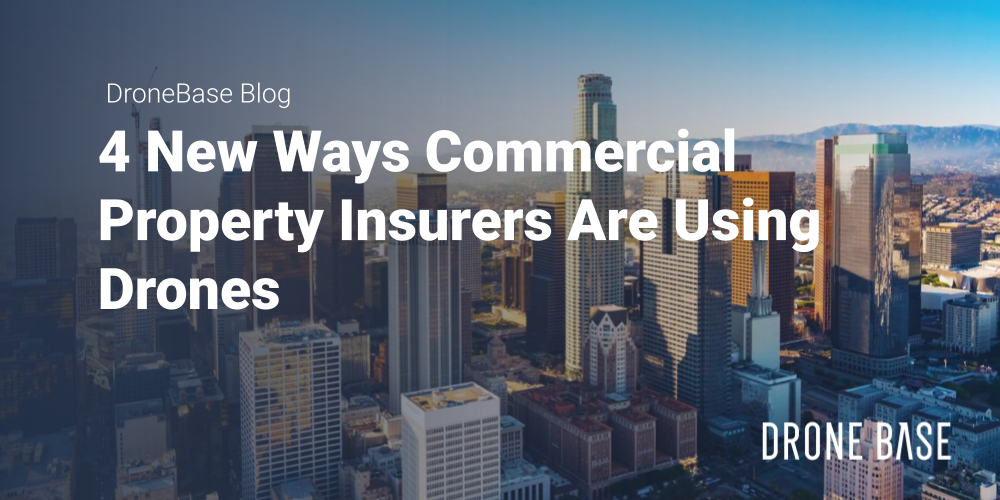Drones have come a long way in the last ten years — and the software and sensors that provide customer data have evolved even faster. This has given companies more tools to innovate and solve challenges in new ways. Insurance companies are a prime example, especially regarding challenges posed by remote work and the great resignation and high-value assets like commercial properties.
Insurance carriers were early adopters of drone technology and continue to be at the forefront of innovation.
Here are four interesting ways that insurance companies are using drones today:
1.) A more efficient distributed workforce
Like many other companies, DroneBase’s insurance customers are evolving how they work. With the rise of distributed teams and hybrid or fully remote work arrangements, it's more critical than ever to have technology that supports digital collaboration. The DroneBase Property Insights platform puts virtual inspections in the hands of experts, including remote workers, contractors, and teams in offices anywhere in the world.
Our insurance customers rely on Property Insights as a single source of high-resolution drone data. They can quickly and easily order, share, and collaborate on a property inspection report from anywhere.
This provides much convenience for our insurance carriers, but more importantly, it’s reducing the time-to-quote and the time-to-claim resolution. This is a competitive advantage for our customers in an industry where time translates directly to revenue.
2.) On-demand team scaling via drone inspections
The volume and timeline of inspections vary throughout the year for an insurance carrier. Property Insights allows any line of business to quickly scale the number of inspections without hiring more full-time employees.
Drones expand the reach of an insurance company’s in-house resources. At DroneBase, we help risk management, loss control, underwriting, and claims teams focus on solving their customers’ problems instead of the time-consuming tasks of data collection, analysis, distribution, and management. Our network of 80,000 experienced pilots enables us to fulfill our customers’ requests.
In addition to saving time, drones help keep employees and contractors safer. All of our customers are deeply concerned about the health and safety of their team members, and working on ladders, scaffolding and roofs accounts for some of the most dangerous activities workers face. Drones help to keep team members on the ground more often, preventing injury and reducing workers’ comp claims.
3.) Drones help carriers write policies and pay claims faster
DroneBase is an industry leader in providing inspection data at scale. Our Property Insights platform offers a robust set of inspection tools for insurance companies to quickly assess an asset’s health and potential risks. While our software uses AI to identify anomalies, we also have a team of industry experts on staff who validate the data and create reports that can be distributed to all stakeholders.
Drone inspections provide current data on a roof and, in some cases, the surrounding area. The data collected can allow the underwriting team to analyze risks quickly and precisely, and support intelligent, data-driven decisions.
Drone inspections are essential at the outset, but they’re also crucial to ensure correct premiums and mitigate potential claims as time goes on. For example, DroneBase can set up a program where we inspect the roofs of specific policies coming up for renewal in six months. This allows the carrier to gather necessary information about the roof's state to adjust premiums or encourage a property owner to make needed repairs.
For in-house loss control engineers, it’s helpful to understand a roof’s condition before an inspection. For example, a DroneBase pilot could inspect the roof a few days before a loss control engineer arrives to lead the official review. That way, they can have prior knowledge of roof conditions and focus on the structure's interior, reducing risks and saving time. And, if critical anomalies are found on the roof, the loss control engineer can address them with the policyholder on site.
Inspections over time also create an archive of data about any given roof to provide evidence and speed resolution in case of a claims dispute. Has the roof damage existed for several years, or was it caused by the hail storm last week?
4.) Easy access to critical data in the property system
You’ve probably noticed a theme: Our goal is to help carriers respond to their policyholders as safely, quickly, and intelligently as possible. We’re doing this with drones — and beyond.
Data is only helpful if you can access it when you need it. With robust collaboration and sharing functions, DroneBase Property Insights can get the necessary data into your team's hands without undertaking a burdensome, time-consuming data management and taxonomy project. Users can easily share data with policyholders to provide a bird’s eye view of their properties and the justifications that went into underwriting a policy or resolving a claim.
All aerial inspection data resides in one location, so employees don’t waste time searching the company servers. All team members could have access to the different user rights levels. This is a significant advantage for the underwriting, loss control, and claims teams. When multiple drone flights take place at the exact location, you can find them stored within Property Insights under the address, with a filter feature to view by date of inspection and the ability to toggle back and forth to see changes over time.





.png?width=360&name=Banner%20Templates%20(4).png)